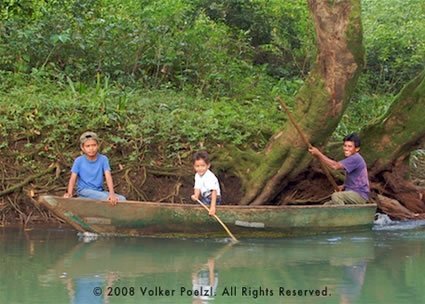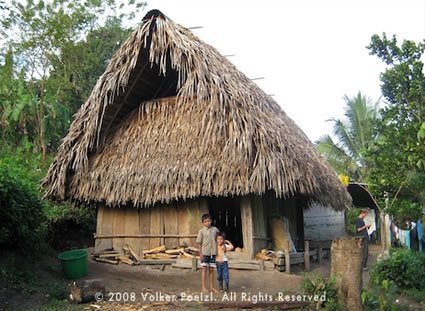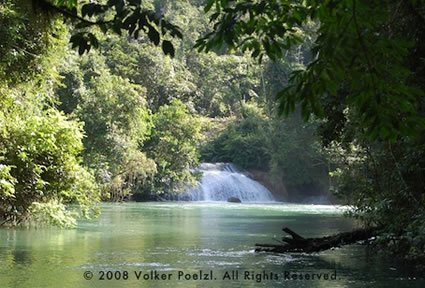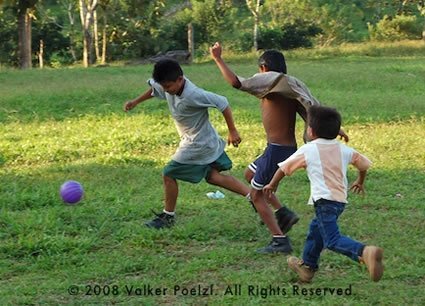A Day in the Life of a Mayan Village
Indigenous Community-Based Tourism in Guatemala
Article and photos by Volker
Poelzl

|
|
Canoes are an important means
of transportation for many Mayans.
|
Canoes are an essential means of transportation for many Mayans.
Guatemala is among Central America's most popular travel destinations. About a million tourists flock to the small country each year to visit Mayan ruins, colonial towns, and, of course, the colorful Mayan markets, among the highlights of any visit to Guatemala. Although many visitors admire and purchase Mayan handicrafts and textiles, listen to marimba bands, and photograph colorful market scenes, very few travelers venture a step further to actually visit Mayan villages and learn about the culture and way of life of the Mayan people. Several NGOs are promoting stays in Mayan villages all across Guatemala to offer an alternative to the main tourist trail that leads from Antigua to Lake Atitlán and the famous Chichicastenango market. These visits give travelers the unique opportunity to go beneath the surface and experience the Mayan culture and way of life. In some areas, the local NGOs also collaborate with aid organizations, allowing visitors to volunteer. At the same time, they stay in a village or with a Mayan family.
What to Expect in a Mayan Village in Guatemala
Most NGOs offering cultural immersion programs operate in little-visited areas in Guatemala and work with small communities. One of the main attractions of these programs is experiencing the way of life of the local people. In addition, these programs allow participants to explore Guatemala's fascinating ecosystems, such as cloud forests, remote mountain valleys, dense rainforests, and mangrove-lined lagoons. Staying with a local family or at a village guesthouse is a great experience. Still, visitors should be aware of local conditions before entering remote areas.
Road conditions in remote villages are usually poor, and you will travel at least part of the way on dirt roads. Expect to spend several hours in a small and crowded minivan with other villagers, their children, chickens, and produce. Not all villages have electricity, and connections to the outside world are often difficult. There may only be one telephone in the town, and in smaller communities, there is only one daily bus or van back to town.
Visitors stay at a village guesthouse or in the hut of a local family, enjoy their meals with their hosts, and are offered a variety of activities, such as cultural events and excursions to the nearby natural attractions. You can also accompany your hosts on their daily work routines, such as visiting agricultural plots or fishing. Village guests are encouraged to sample traditional foods. Still, since the villages are poor, you will most likely be served simple meals. In addition to vast piles of corn tortillas, the leading staple food of the Mayans, my host family in a small jungle village in the Verapaces region served eggs, chicken, pasta, and beans, which was a simple but varied enough menu plan to keep me well fed for a few days. If bottled water is unavailable, bringing a water filter or purification tablets is a good idea. Also, get all the extra food and drink you want to consume during your stay. Some basic items and soft drinks may be available at village stores. If you bring snacks or sweets, keep the village children in mind and buy a little extra to share.

|
|
My host family's hut in the northern
Guatemalan rainforest.
|
My host family's hut in the northern Guatemalan rainforest.
Village guesthouses are more comfortable and better equipped, offering more privacy than staying in a hut with a host family. If privacy and creature comforts are essential, consider a village stay, where you can have your private room at a community guesthouse. Bedding may not always be up to Western standards, and bringing a camping mattress and/or sleeping bag might be a good idea if you can. Do not expect private bathrooms or showers when staying with a local family in a hut. Most villagers bathe in the nearest creek, which is always a great place for socializing in the late afternoon when people bathe after a day's work in the fields. There are usually outhouses shared by several families. In villages without electricity, candles provide the only lighting after dark, and families go to bed very early. Bring a flashlight and a lantern if you plan to stay up late.

|
|
Many villages that host guests have nearby natural attractions.
|
Remember that you are a guest of the village and your host family, not just a tourist. A low-cost stay in a Mayan village should not be considered a cheap alternative to hotel accommodation. Spending a few days in a remote indigenous community differs from staying at a guesthouse or hotel. Staying in a Mayan village is an unexpected opportunity to accompany the villagers or your host family on their daily activities and learn about their livelihoods, food, and family life. You will be part of the family life, stay in the common areas with your host family, and have little privacy. My travel companion and I shared a large thatched hut with the rest of the family during the night. Expect your host's children to accompany you wherever you go. Your visit is a welcome change in their routine, and they will be incredibly attentive if you speak some Spanish and are willing to play soccer with them.

|
|
Soccer is the favorite game of
many Mayan children.
|
The Benefits of Your Visit
With the Mayans
Many of the village stay programs are located in areas of new settlements, primarily by Mayan people of different ethnic backgrounds who were displaced by fighting during their civil war. These families fled their home communities and moved to remote mountain and jungle areas to start a new life. Many of these villages are under 20 and receive little government aid for infrastructure and development. Forests, rivers, and lakes are the primary sources of income and livelihood, and growing deforestation, overhunting, and over-fishing have an irreversible impact on fragile local ecosystems. In some regions, the local village communities are paid by the national parks administration to maintain and protect small forest reserves that act as buffer zones for adjacent national parks. This stewardship program is one of the few sources of income for many communities, in addition to small lots of cash crops such as cardamom, corn, and beans.
Although the small number of foreign visitors does not significantly impact the local economy, they still contribute positively to the preservation of the natural environment through their visit. Hikes and excursions to natural wonders are among the main attractions of many community tourism projects, and your visit encourages the continued protection and sustainable use of the local ecosystem. Staying in the village is not only a great cultural experience but also gives the locals a further incentive to protect their ecological treasures that attract visitors and bring income to the community.
Where to Go in Guatemala to Experience Mayan Culture
Travelers need to be prepared to leave the Gringo trail and venture into remote and little-visited regions of Guatemala to experience Mayan culture and way of life. Although access is often time-consuming and challenging, visitors will be rewarded with a rich experience of the diverse ethnic groups that make up Guatemala's Mayan population. Below, I have listed several regions in Guatemala where NGOs help native villages with community tourism projects.
The Cuchumatán Mountains in Guatemala
I have found the Cuchumatán Mountains to be one of the most fascinating regions in Guatemala to experience local Mayan life. The imposing mountain range stretches across northern central Guatemala. It is home to many small towns and communities, where visitors can get a first-hand experience of the daily life of the local population and their culture. This area was strongly affected by the Guatemalan civil war when many villagers were displaced by the fighting between the Guatemalan army and guerilla groups. Life is slowly returning to normal, but the remote mountain communities are economically underdeveloped and lack many services. The town of Nebaj is an excellent base from where to organize a stay in a local village.
The Verapaces Region
The Verapaces region is situated in northern Guatemala, in a transitional zone between the Guatemalan highlands and the low-lying plain of the Yucatán Peninsula. It is equally divided between mountains covered in cloud forest and low-lying rainforest to the north, offering visitors a fascinating and diverse ecosystem that is home to rare fauna and flora, such as the rare and endangered Quetzal, Guatemala's national bird, as well as numerous indigenous Mayan communities. Cobán is the region's capital, a pleasant town surrounded by coffee plantations. It is here where visitors can make arrangements for a cultural immersion experience in local Mayan communities.
The Rain Forest of Petén
Petén, Guatemala's northernmost department, is a low plain at the southern tip of the Yucatán Peninsula. It is covered with dense rainforest and is a sparsely populated region. Besides tourism to the famous Mayan ruins of Tikal, there is little tourism development and infrastructure. Several NGOs and community projects offer stays in Mayan villages to experience the local culture, visit remote Mayan ruins, and explore the region's rich fauna and flora.
The Rio Dulce / Golfete Region
The Rio Dulce drains Eastern Guatemala and reaches the Caribbean Sea near Livingston. As in many other parts of Guatemala, the banks of the Rio Dulce, part of a national park, have been settled by Mayans who fled the civil war violence in their home communities. Most of these settlements are illegal, and government services are absent. To help these newly established communities, several NGOs and community projects have begun to develop a basic infrastructure to attract socially and environmentally responsible travelers. Several villages offer homestays, stays at community guesthouses, and guided tours to explore the region's rich ecosystem.
Volker
Poelzl is a Living Abroad Contributing
Editor for TransitionsAbroad.com. During his recent trip to Guatemala, he visited several indigenous communities throughout the country.
|
